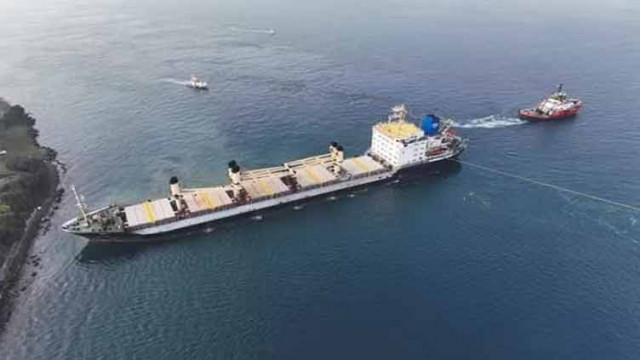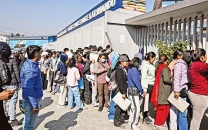Explainer: Can Ukraine's grain corridor ease the global food crisis?
The deal to free up grain exports from Ukraine's southern Black Sea ports was extended on Nov. 17 for 120 days

It is unclear whether Moscow will extend its participation in a U.N.-backed initiative that has enabled grains to be exported from Ukraine's Black Sea ports.
Russia said on Monday it would be "inappropriate" to extend the Black Sea grain deal unless sanctions imposed on Moscow following its invasion of Ukraine on Feb. 24 last year that have affected its agricultural exports are lifted.
The deal to free up grain exports from Ukraine's southern Black Sea ports was extended on Nov. 17 for 120 days.
Sources familiar with the matter, speaking on condition of anonymity, said the deal needs to be renewed by around March 20 at the latest for exports to continue.
Reached in July last year, it created a protected sea transit corridor and was designed to alleviate global food shortages by allowing exports to resume from three ports in Ukraine, a major producer of grains and oilseeds.
Here are some of the issues:
WHAT HAS BEEN EXPORTED?
Under the pact to create a safe shipping channel, some 21.1 million tonnes of agricultural products have been shipped, including 10 million tonnes of corn.
Wheat shipments have reached 6 million tonnes, or 28% of the total. Other commodities shipped include rapeseed, sunflower oil, sunflower meal and barley.
HOW MIGHT THE AGREEMENT CHANGE?
Russia seeks the removal of sanctions on its agricultural exports in return for its continued backing of the pact.
Agricultural exports have not been explicitly targeted by sanctions, but Moscow says blocks on its payments, logistics and insurance industries are a barrier to the export of its grains and fertilisers.
Among its demands, Russia is believed to want the West to ease restrictions on state agriculture lender Rosselkhozbank, which should facilitate Russian exports.
Ukraine has not made public any changes it is seeking, but in the run-up to the November agreement, it sought unsuccessfully to have the deal expanded to include more ports.
The three ports involved in the deal - Odesa, Chornomorsk and Pivdennyi - have the combined capacity to ship around three million tonnes a month.
Ukraine wanted to include the ports of the southern Mykolaiv region, which provided 35% of Ukrainian food exports before Russia's invasion.
Mykolaiv was Ukraine's second-largest grain terminal according to 2021 shipment data so its addition would allow a much larger volume of grains and oilseeds to be shipped.
Ukraine had separately sought a one-year extension of the deal and a streamlined inspection regime.
HAS IT ALLEVIATED THE FOOD CRISIS?
Reduced shipments from major exporter Ukraine have played a role in the global food price crisis.
Other factors include the COVID-19 pandemic and climate shocks that continue to challenge agricultural production, including droughts in both Argentina and the United States.
The corridor has led to a partial recovery in shipments from Ukraine but they remain well below pre-invasion levels and will not fully recover for the foreseeable future.
Transporting grains to and from ports there is challenging and expensive, and Ukrainian farmers have reduced sowings of crops such as wheat after in many cases selling last year's crops at a loss because domestic prices were very low.
HAS IT DRIVEN DOWN GLOBAL WHEAT PRICES?
Prices of wheat on the Chicago Board of Trade rose sharply following Russia's invasion of Ukraine on Feb. 24, 2022.
They are now around pre-conflict levels as Ukraine's ability to export millions of tonnes of wheat through the corridor helped to lower prices.
Other factors include a record crop in major exporter Russia last year, the gloomy global economic outlook and a strong dollar.
Also read: Israeli troops kill Palestinian, 17, in West Bank clash, medics say
Prices for wheat-based food staples, such as bread and noodles, are still well above pre-invasion levels in many developing countries despite the decline in Chicago futures, as weak local currencies and higher energy prices have raised costs such as transport and packaging.
WHAT ABOUT SEA MINES?
Russia and Ukraine accuse each other of planting naval mines that float around the Black Sea, posing a significant threat. A crew member on the Sierra Leone-flagged Razoni, the first ship to pass through the corridor on Aug. 1 cited them as a concern.
The mines have drifted far from Ukraine's shores, and Bulgarian, Romanian and Turkish military diving teams have defused some that have ended up in their waters.
Clearing the rest could take months and there was not enough time to do so before the grains pact came into effect.
WHAT ABOUT INSURANCE?
The Istanbul based Joint Coordination Centre, which oversees the deal and is made up of Russian, Turkish, Ukrainian and U.N. officials, in August published procedures on the shipping channel to address the concerns of insurers and shipowners.
Insurers initially said they were willing to provide cover if there were arrangements for international navy escorts and a clear strategy to deal with sea mines.
Since then, they have created clauses for providing cover, including provisos that ships need to stay inside the corridor when transiting or risk invalidating their policies.
Following the July 22 agreement, Lloyd's of London insurer Ascot and broker Marsh (MMC.N) set up a marine cargo and war insurance facility for grain and food products moving out of Ukrainian Black Sea ports with $50 million cover per voyage.
The cost of overall insurance for ships sailing into Ukrainian ports - which includes separate segments of cover - is nevertheless likely to remain steep.
This has been compounded by insurers having to cover more of the risk after reinsurers at the start of this year introduced exclusions for Belarus, Russia and Ukraine, meaning more exposure for insurers and potentially less appetite to cover cargoes.
WHAT ABOUT CREWS?
In September, Ukraine implemented a decree allowing its seafarers to leave the country despite wartime restrictions, a move aimed providing a workforce to deal with Ukrainian grain exports and for the wider global shipping industry.
At the start of the conflict there were around 2,000 seafarers from all over the world stranded in Ukrainian ports.
Industry estimates show over 300 crew members are stuck in Ukraine.



















COMMENTS
Comments are moderated and generally will be posted if they are on-topic and not abusive.
For more information, please see our Comments FAQ